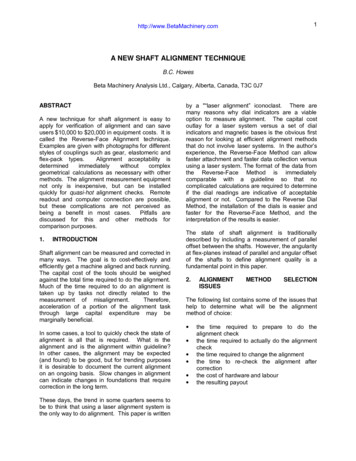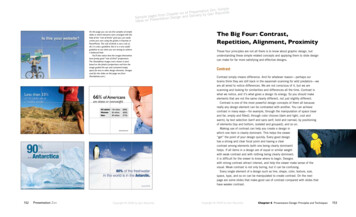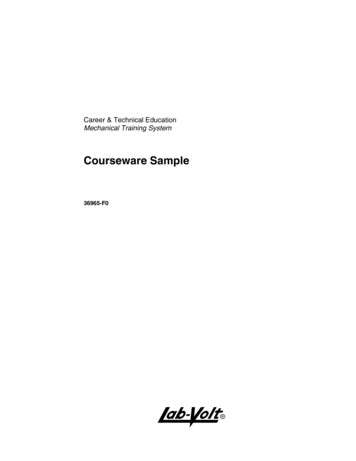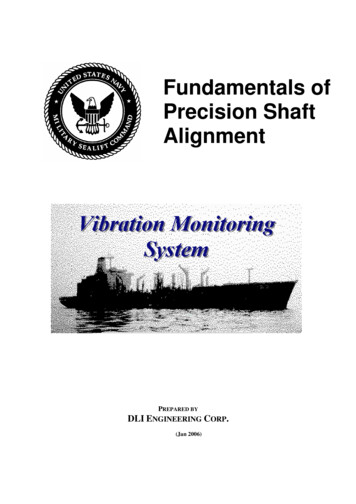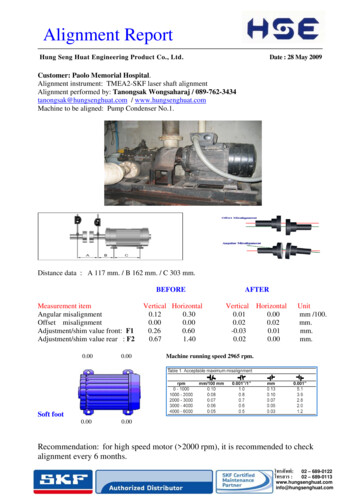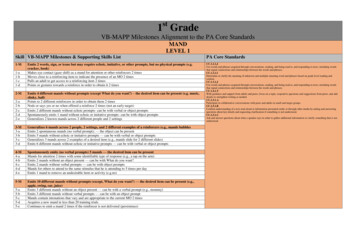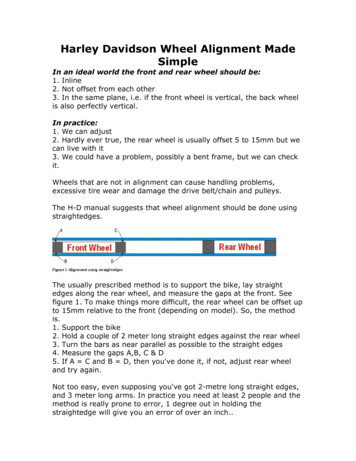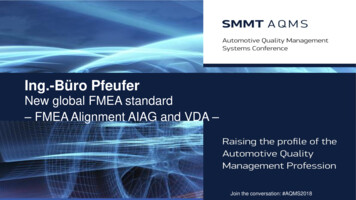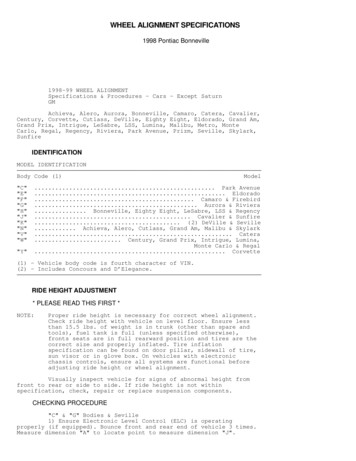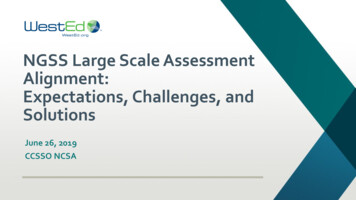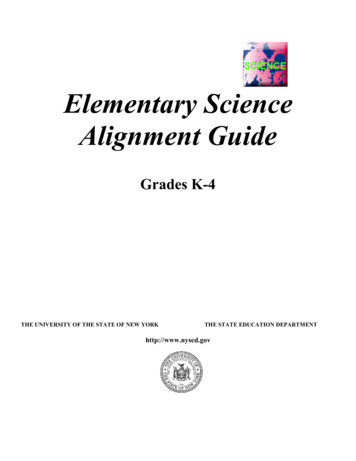
Transcription
Elementary ScienceAlignment GuideGrades K-4THE UNIVERSITY OF THE STATE OF NEW YORKTHE STATE EDUCATION DEPARTMENThttp://www.nysed.gov
THE UNIVERSITY OF THE STATE OF NEW YORKRegents of the UniversityCarl T. Hayden, Chancellor, A.B., J.D. . ElmiraAdelaide L. Sanford, Vice Chancellor, B.A., M.A., P.D. . HollisDiane O’Neill McGivern, B.S.N., M.A., Ph.D. . Staten IslandSaul B. Cohen, B.A., M.A., Ph.D. . New RochelleJames C. Dawson, A.A., B.A., M.S., Ph.D. PeruRobert M. Bennett, B.A., M.S. . TonawandaRobert M. Johnson, B.S., J.D. HuntingtonAnthony S. Bottar, B.A., J.D. . North SyracuseMerryl H. Tisch, B.A., M.A. New YorkEna L. Farley, B.A., M.A., Ph.D. BrockportGeraldine D. Chapey, B.A., M.A., Ed.D. . Belle HarborArnold B. Gardner, B.A., LL.B. . BuffaloCharlotte K. Frank, B.B.A., M.S.Ed., Ph.D. . New YorkHarry Phillips, 3rd, B.A., M.S.F.S. . HartsdaleJoseph E. Bowman, Jr., B.A., M.L.S., M.A., M.Ed., Ed.D. AlbanyLorraine A. Cortés-Vázquez, B.A., M.P.A. . BronxPresident of The University and Commissioner of EducationRichard P. MillsChief Operating OfficerRichard H. CateDeputy Commissioner for Elementary, Middle, Secondary, and Continuing EducationJames A. KadamusAssistant Commissioner for Curriculum, Instruction, and AssessmentRoseanne DeFabioAssistant Director for Curriculum and InstructionAnne SchianoThe State Education Department does not discriminate on the basis of age, color, religion, creed, disability, marital status,veteran status, national origin, race, gender, genetic predisposition or carrier status, or sexual orientation in its educational programs,services and activities. Portions of this publication can be made available in a variety of formats, including braille, large print or audiotape, upon request. Inquiries concerning this policy of nondiscrimination should be directed to the Department’s Office for Diversity,Ethics, and Access, Room 530, Education Building, Albany, NY 12234.
AcknowledgementsThe Elementary Science Alignment Guide was developed with the input from practitioners and administratorsinvolved in science education. The completion of this document was achieved as a result of the efforts of manyoutstanding individuals listed below, who gave generously of their time and expertise.Principal WritersThe following persons coordinated and supervised the development of this document and contributed significantlyto the content included in this document.Ann CrottyNew York State Education DepartmentOffice of Curriculum and InstructionScience AssociateVirginia HammerNew York State Education DepartmentOffice of State AssessmentAssistant in Education TestingDiana HardingNew York State Education DepartmentOffice of Curriculum and InstructionScience AssociateJudy PinsonnaultNew York State Education DepartmentOffice of State AssessmentAssociate in Education TestingContributorsThe following persons contributed to the content included in this document.Mike JabotProfessor, Science EducationState University of New York at FredoniaLinda KostunElementary TeacherAverill Park Central School DistrictLaura LehtonenScience CoordinatorSchool Support ServicesCapital Region BOCESLinda MorrisElementary TeacherProfessional Development SpecialistCapital Region Science Education PartnershipTerry O'BrienElementary TeacherWatervliet City School DistrictCarolyn SmithElementary TeacherEnlarged School District of TroyRobert WhitemanElementary TeacherGuilderland Central School Districtiii
ReviewersThe following persons reviewed and provided recommendations incorporated in this document.Gregory BormanSpecial Education TeacherDistrict 75, New York CitySteven KalliesDistrict SuperintendentOneida-Herkimer-Madison BOCESDarylle BrentPresidentScience Council of New York CityMargarita MayoBusiness Council of New York StateSteve BrownScience TeacherEast Islip High SchoolRod DoranProfessor, Science EducationUniversity at Buffalo, State University of New YorkJackie GarelickElementary TeacherMargaretville Central School, MargaretvilleClark GodshellDistrict SuperintendentOrlean-Niagara BOCESGail HirstSCDN Executive DirectorCattaraugus-Allegany-Erie-Wyoming BOCESNYSUT Subject Area Committee for ScienceNew York State United TeachersRobert ScoffieldSuperintendentHammond Central School DistrictBruce TullochPresidentScience Teachers Association of New York StateAndy VerdonSupervisor of Instructional ServicesDutchess County BOCESPat ZuckElementary Science CoordinatorOneida-Herkimer-Madison BOCESiv
CONTENTSAcknowledgments. iiiIntroduction to the Elementary Science Alignment Guide . 1Purpose, Background . 1Changes. 1Comparison Table for Elementary Science Tests . 2Transitioning to the Elementary Science Core . 3Using the Elementary Science Core Curriculum Guide and the Elementary Science Alignment Guidefor Curriculum Development and Professional Development . 3Matrix A. 5New York State Program Evaluation Test in Science Objective Test, Form H, Alignment to theElementary Science Core Curriculum Guide and the Elementary Science SyllabusTest Items 1-15 . 5Test Items 16-28 . 11Test Items 29-45 . 17Matrix B . 26New York State Program Evaluation Test in Science Performance Test, Form Z, Alignment to theElementary Science Core Curriculum Guide and the Elementary Science SyllabusStation #1 Liquids . 26Standard 1 . 26Standard 4 . 27Station #2 Grouping Objects. 29Standard 1 . 29Standard 4 . 29Station #3 Ball and Ramp . 31Standard 1 . 31Standard 4 . 34Station #4 Magnetic and Mechanical Testing. 35Standard 1 . 35Standard 4 . 36Station #5 Unknown Object. 39Standard 1 . 39Standard 4 . 40Summary Charts. 41Appendix A. 43v
Introduction to the Elementary Science Alignment GuidePurposeThe purpose of the Elementary Science Alignment Guide is to give science educators information about theproposed changes in New York State's elementary-level science test and tools to help them make changes in theircurriculum during this transition from a syllabus-based test to a standards-based test. The document consists ofdescriptions of the current and future elementary science tests, and matrices and a summary chart showing how thecurrent test aligns to the New York State Elementary Science Syllabus and the standards-based Elementary ScienceCore Curriculum Guide.When used with the existing science core curriculum guides and test sampler documents, this alignment document isone more tool that can assist school districts in: Aligning their K-12 science curriculum, instruction, and assessment practices with the New York Statelearning standards; Identifying and addressing strengths and weaknesses in the science program; and Addressing their teachers' professional development needs.BackgroundThe New York State learning standards describe what all students are expected to know and be able to do at threelevels in their academic careers elementary, intermediate, and commencement. In order to give schools theinformation they need about how their students are progressing in science, the Education Department is designing anew elementary-level science test to be administered at the end of grade 4. An intermediate-level science test,administered at the end of grade 8, was introduced in 2001. Because these tests are aligned to the same standards asthe commencement-level (Regents) science examinations, student results on the elementary and intermediate sciencetests are good indicators of student success in high school science. Results can also provide indicators of a student'sweaknesses; these areas can then be addressed locally through the provision of academic intervention services(AIS).Before the adoption of the New York State learning standards, the basis for elementary science programs was theNew York State Elementary Science Syllabus. The New York State Program Evaluation Test in Science (sometimesreferred to in the field as ESPET) is aligned to the Elementary Science Syllabus. The test design, or blueprint, wasintroduced in 1989 and has remained the same with new sets of questions (forms) introduced every three years. Themost recent form of the New York State Program Evaluation Test in Science was first administered in May 2000(see Appendix A for a detailed description of this test). This form will be in use through May 2003. The New YorkState Program Evaluation Test in Science was designed to assist schools in evaluating and improving theirelementary science program in relation to the science syllabus. Each year, schools are provided with a Guide toProgram Evaluation to assist them in local program evaluation activities.With the introduction of the New York State learning standards, the purpose of the New York State ProgramEvaluation Test in Science changed somewhat. The data for the performance portion of the test (five hands-onscience stations of which each student completes three) is still used for program evaluation. However, the objectiveportion (45 multiple choice questions) is now also used for individual student evaluation. Beginning in May 2000,students who score below 30 on the objective test need to be provided AIS. This score was arrived at through astandard-setting procedure involving New York State teachers.ChangesIn May 2004, grade 4 students will be required to take the new Grade 4 Elementary-Level Science Test. Thisindividual student test will replace the New York State Program Evaluation Test in Science, which will be given forthe last time in May 2003. The new test will measure achievement of the New York State learning standards throughits alignment to the Elementary Science Core Curriculum Guide. The test will reflect the content and process skillsdetailed in this Core. A working draft of the Elementary Science Core Curriculum Guide was distributed to schoolsin March 2000. The final version can be found on the New York State Education Department website athttp://www.emsc.nysed.gov/ciai/.1
The Grade 4 Elementary-Level Science Test will have a written component and a performance component. Theformat of the written component will parallel the Grade 8 Intermediate-Level Science Test as well as the Regentsscience examinations. It will consist of multiple choice questions, constructed response questions, and extendedconstructed response questions. A test sampler will be distributed to schools in 2003.The comparison table below provides information about the current New York State Grade 4 Program EvaluationTest in Science and the new Grade 4 Elementary-Level Science Test to be administered in the spring of 2004.Comparison TableTests in Elementary ScienceTest DescriptionNew York StateProgramEvaluation Testin Science,Grade 4Grade 4ElementaryLevel ScienceTestTest PurposeObjective Test (Form H)To assess individual studentachievement of learningstandards in science at theelementary level for thepurpose of providingacademic interventionservices. Objective test is alsoused for program evaluation.Test AlignmentNew York StateElementary ScienceSyllabus,and theMathematics, Science,and TechnologyLearning Standards1, 3, and 4Performance Test (Form Z)To help districts/schoolsevaluate effectiveness ofelementary science programs.(The Guide to ProgramEvaluation K-4 is providedfor this purpose.)Objective ComponentPerformance ComponentTo assess individual studentachievement of learningstandards in science at theelementary level for thepurpose of providingacademic interventionservices. (A programevaluation guide will not beprovided.)Mathematics, Science,and TechnologyLearning Standards 1and 4New York StateMathematics, Science,and TechnologyLearning Standards 1and 4, as well as 2, 6,and 7 as described inthe Elementary ScienceCore Curriculum GuideTest StatusCurrent testadministeredannually inMay from2000through2003Test FormatObjective Test,Form H,45 multiplechoicequestionsPerformanceTest, Form ZFive stations(studentstake three)Future testadministered forthe first time inMay 2004Written testconsists ofmultiple choice,constructedresponse, Test, Form AFewer stations;each studentwill take allstationsAppendix A, included in this document, contains a field memo dated June 1999 from Gerald DeMauro, Coordinatorof State Assessment. This memo describes the components of the current New York State Grade 4 ElementaryScience Program Evaluation Test. It has been provided as a reference for convenience.2
Transitioning to the Elementary Science Core CurriculumThe challenge facing many elementary science educators in the next two years will be transitioning from thesyllabus to the Core as a basis for elementary science curriculum. While the Core should be the major focus, thesyllabus-based test will remain in use through May 2003. This Elementary Science Alignment Guide is designed tosupport school districts in transitioning from a syllabus-based curriculum to a standards-based curriculum. Schooldistricts are encouraged to use the Elementary Science Core Curriculum Guide and this alignment document toenhance curriculum and professional development in science. The materials provide an alignment of the currentNew York State Program Evaluation Test in Science (sometimes referred to as ESPET) to both the ElementaryScience Syllabus and the Elementary Science Core Curriculum Guide.Using the Elementary Science Core Curriculum Guide and the Elementary Science Alignment Guide forCurriculum Development and Professional DevelopmentElementary Science Core Curriculum Guide The Elementary Science Core Curriculum Guide provides an additional level of specificity to the learningstandards for mathematics, science and technology. The Core covers Standard 4 Physical Setting and LivingEnvironment concepts at the elementary level and appropriate sections of Standards 1, 2, 6, and 7. For each keyidea, the performance indicators and major understandings have been elaborated to identify which scienceconcepts are important for elementary students to know and understand.Matrices and Summary Chart Matrix A aligns the Objective Test, Form H, to the science learning standards contained in the ElementaryScience Core Curriculum Guide and to the material in the Elementary Science Syllabus. Matrix B aligns the Performance Test, Form Z, to the science learning standards contained in the ElementaryScience Core Curriculum Guide and to the material in the Elementary Science Syllabus. Summary Charts 1 and 2 summarize the information contained in Matrices A and B.Curriculum DevelopmentAt the district level, science curriculum committees should b
Guilderland Central School District . Linda Morris . Elementary Teacher . one more tool that can assist school districts in: Aligning their K-12 science curriculum, instruction, and assessment practices with the New York State . tests are good indicators of student success in high school
